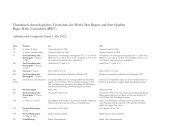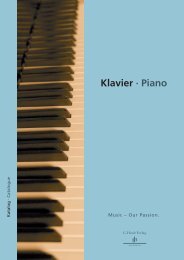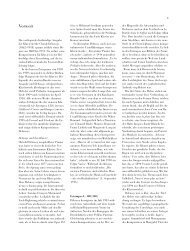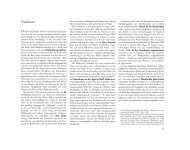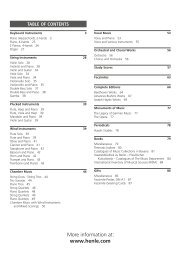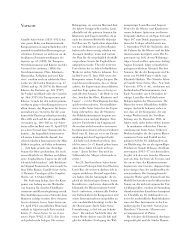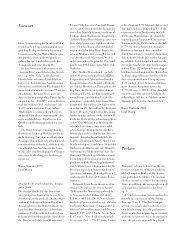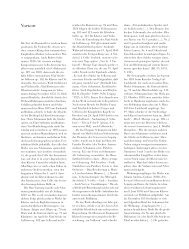Create successful ePaper yourself
Turn your PDF publications into a flip-book with our unique Google optimized e-Paper software.
Möglichkeit, alle vier Walzer in ihrencharakteristischen Eigenarten zu entdecken.Fanden die drei gedruckten Valsesoubliées wie das Spätwerk Liszts im Allgemeinenkaum Beachtung bei den Zeitgenossen,so verbreiteten sie sich dochsehr schnell innerhalb seines Schülerkreises.Dagegen wissen wir nicht, obdie vierte Valse oubliée überhaupt jemalszu Liszts Lebzeiten gespielt wurde.Göllerichs Tagebuchaufzeichnungengeben uns interessante Einblicke, wieLiszt sich den Charakter und die Ausführungeiniger Stellen vorstellte. (Beiden folgenden Zitaten aus Liszts Klavierunterrichtsind die Taktzahlen hinzugefügt,da die Seitenzahlen in denAufzeichnungen Göllerichs auf die Ausgabenvon Bote & Bock bezogen sind.)(Première) Valse oubliée„Die Akkorde anfangs ziemlich starkund ganz kurz. Das 1. Thema nicht zulangsam. Das 2. Thema, Seite 2 (scherzando)[T. 49 ff.] leicht, pikant und,frei‘ tändelnd spielen. Auf Seite 6 dasThema elegisch spielen; nicht zu walzermäßig.Seite 8 rechts [T. 140 ff.] schnellund viel trillern, auch das Tempo beschleunigen.Das Thema zum Schlusse[T. 193 ff.] wieder etwas traurig und gefühlvoll.“(18. Februar 1886, S. 127.)„Die Anfangstakte von Nr. I. sehr staccato,sehr gestoßen. Beim 2. Thema[T. 49 ff.] den Unterschied zwischen dengebundenen und den staccato-Stellenrecht ordentlich hervorheben. – ,Da dieLeute nicht zufrieden sind, wenn sienicht am Schlusse einen Akkord hören,so können Sie ja da am Ende ein paarAkkorde anbringen.‘ Er machte eben 2Akkorde in der Tonart.“ (10. Juli 1885,S. 84.)Deuxième Valse oubliée„Auf Seite 4 [T. 17 ff.] sagte der Meisterdaß die 2 ersten Sechzehntel immerdoch nicht zu sehr aneinander gespieltwerden dürfen, sondern etwas getrenntsein müssen. Bei den Passagen rechts inder letzten Zeile sagte Er: ,ich mache Sieaufmerksam, daß wenn Sie öffentlichspielen, die Noten eben immer bei Passagengut klingen müssen und deshalbdoch gut anzuschlagen sind im Piano.‘ –Das Thema S. 6 [T. 79 ff.] eher ziemlichrasch und sehr keck und lustig – derMeister schlug dabei köstlich fesch indie Hände wie im höchsten Übermut.Bei dem nächsten Thema nicht zu langsamesTempo und ,recht deutlich‘. Beider letzten Zeile, S. 9 [T. 157 ff.], sagteEr, ,Der braucht lange bis er fertigwird.‘ Seite 16 [T. 291 ff., die Stelle abT. 300], ,noch immer weiß der fade Kerlwas und wird nicht fertig‘. Die paarTakte S. 17, letzte Zeile [T. 339 ff.] sehrlustig immer und links fesch gestoßen. –,Zum Schluß können Sie noch einenForte-Akkord anbringen.‘“ (10. Juli1885, S. 85.) „Nr. 2. Seite 7 [recte: 17,T. 322 ff.] das Quinten-Thema nicht zuschnell und die einzelnen Akkorde ziemlichfest, nicht zu leicht spielen.“(18. Februar 1886, S. 127.)Troisième Valse oubliée„Das Crescendo der 8tel-Oktaven[T. 141 ff.] ordentlich herausbringen,die Oktaven stark, das Tempo im Anfangenicht zu rasch, wiegend.“ (8. Juli1885, S. 81.)Ausführliche Angaben zu den Quellenfinden sich in den Bemerkungen amEnde der vorliegenden Ausgabe. Dortsind auch die wichtigsten Lesarten mitgeteilt.Für freundlich zur Verfügung gestellteQuellenkopien sei den in den Bemerkungengenannten Bibliotheken herzlichgedankt.Budapest, Herbst 2010Mária EckhardtPrefaceVIn late 1880, the Hanover publisherArnold Simon returned to Franz Liszt(1811–86) the manuscript of a pianoromance which Simon had accidentallyrediscovered. Liszt had written it in1848, but the work had never been publishedand the composer had long sinceforgotten about it. The piece was anarrangement of a song written in 1843and published the following year, Lespleurs des femmes (“Oh pourquoi donc,”text by Caroline Pavloff). Simon wantedto publish this early work and askedLiszt for his permission. The composertook this as an opportunity to revise themelody and give it a new title, Romanceoubliée (Forgotten Romance). It waspublished in 1881 in four different versions:for piano solo, for viola and piano,for violin and piano, and for violoncelloand piano. Shortly after Liszt’sdeath, the publisher Christian Bachmannacquired the Romance oubliéefrom Simon and reprinted it, adding thestory of its origins to the verso of thetitle page.Liszt’s work on the Romance oubliéeapparently provoked a strong emotionalreaction within the nearly 70-year-oldcomposer, for shortly thereafter, in thesummer of 1881, he composed a Valseoubliée. The piece was written after hehad suffered a fall on the staircase of hisWeimar residence on 2 July and wasobliged to keep to his bed for eightweeks. During this time, he had ampleopportunity to reflect upon his life andworks. Though the title reads only Valseon the autograph dated “23 Juillet 81,”in his letter of 9 August 1881 to HugoBock, Liszt offered the publisher thepiece under the title “Vergessener Walz[er]– Valse oubliée” (Franz RudolfJung, Franz Liszt in seinen Briefen, Berlin,1987, letter no. 148, p. 280). Sincethe publisher immediately handed overthe requested honorarium, Liszt wroteto him on 8 September 1881: “Theengraving of the ‘Forgotten Waltz’ canbe undertaken straightaway” (letterno. 149). Bote & Bock published the
VIpiece in late 1881 under the title“Valse oubliée | (Vergessener Walzer).”“Oublié” (forgotten) became a kind ofemblematic concept for the composer: itstood for remembrance and, at the sametime, for certain musical forms and genresthat time had passed over. In theearly 1880s, the old romances were justas archaic and out-of-date as the ingratiatingpiano waltzes that Liszt had cultivatedin his early years. The Valse oubliée,later supplied with the ordinalnumber Première, evokes this bygonetime, but with a certain distancing effect.While not disclaiming virtuosity orelegance, Liszt permeates the piece withnostalgia and irony, and alludes to thehistorical position of such pieces by embeddingtypical melodic and rhythmicformulae of the salon waltzes into an innovative,non-tonal framework that ischaracteristic of his late style. However,the romantic title page of the first edition,which is adorned with colourfulflowers, a sleeping genius, musical instrumentsand a ribbon inscribed “Souvenir,”does little to convey this aspect ofthe music.Liszt did not let himself be deterredby the reserved reception accorded tohis first “forgotten waltz,” and wrotethree more Valses oubliées in the followingyears. “I merely have forgottenthings – a valse, a romance oubliée etc.A polka oubliée is also on its way,” hereported on 8 July 1885, when a pupilbrought the Troisième Valse oubliée toher lesson (Franz Liszts Klavierunterrichtvon 1884–1886, dargestellt anden Tagebuchaufzeichnungen von AugustGöllerich, ed. by Wilhelm Jerger,Regensburg, 19<strong>75</strong>, p. 81). To AugustGöllerich, who played the first twoValses oubliées on 10 July 1885, hecommented ironically: “So you want tolose your time with something silly for achange? [...] These pieces show that thecomposer never went to a conservatory– he has absolutely no understanding ofthe laws of harmony.” (Liszts Klavierunterricht,p. 84.)On the copy of the Deuxième valseoubliée transcribed by Wilhelm Weberand supplied with addenda and correctionsby Liszt, the date “23 Juillet 83 |Weimar” is inscribed in Liszt’s hand;but in the preceding week he had alreadyplayed it to his biographer LinaRamann as a “novelty of ‘premièrefraîcheur’” (Ramann, Lisztiana, Mainz ,1983, p. 211). There is no date on theautograph work manuscript of the TroisièmeValse oubliée, but this piece wasmost likely also written in 1883. Lisztalso had begun a Petite Valse as a “sequelto the 3 Forgotten Waltzes (Valsesoubliées),” but left it unfinished. Notwithstanding,he wrote a QuatrièmeValse oubliée, which must have beencompleted before mid 1884, since henoted in his lesson of 4 July: “I havewritten another, 4 th valse oubliée!”(Liszts Klavierunterricht, p. 55).Liszt dedicated the Deuxième andTroisième Valses oubliées to his closeWeimar friend, Baroness Olga vonMeyendorff (1838–1926). On 25 February1884 he inquired whether she hadreceived a (manuscript) copy of theTrois Valses oubliées that he had senther, and promised a “printed postscriptum”(The Letters of Franz Liszt to Olgavon Meyendorff, ed. by William R. Tyler/Edward Waters, Washington, 1979,pp. 458 f.). Indeed, a short time later,presumably in March 1884, Bote &Bock published the first three “forgottenwaltzes” as separate editions with acommon title page. The publisher usedthe same romantic title-page design asin the first edition of the first waltz,but this time with the heading TROIS |Valses oubliées | (Vergessene Walzer).The Quatrième Valse oubliée was notpublished during Liszt’s lifetime. It wasfirst printed on the basis of the undatedautograph only in 1954, by TheodorPresser Co. (Bryn Mawr, Pennsylvania,USA), and was published almost contemporaneouslyin a Hungarian editionas a supplement to the journal Új ZeneiSzemle (6 th vol., 1955, nos. 7–8).To this day, only the first Valse oubliéehas found its way into the concertrepertoire. This edition gives pianiststhe chance to discover all four waltzeswith their unique characteristics. Althoughthe three printed Valses oubliées– as well as Liszt’s late works in general– aroused little interest among Liszt’scontemporaries, they spread very quicklywithin the circle of his students. However,it is not known whether the fourthValse oubliée was ever played during thecomposer’s lifetime.Göllerich’s diary entries provide interestinginsights into how Liszt envisionedthe character and execution ofcertain passages. (In the following citationsfrom Liszts Klavierunterricht,we have added the measure numbers,since the page numbers in Göllerich’scomments refer to the Bote & Bockeditions.)(Première) Valse oubliée“The chords at the beginning arequite forceful and very short. Takethe 1 st theme not too slowly. Playthe 2 nd theme, page 2 (scherzando)[mm. 49 ff.] in a light, piquant andflirtatiously ‘free’ style. On page 6 thetheme is elegiac, not too waltz-like.Page 8, right [mm. 140 ff.] fast andwith many trills, with acceleration of thetempo as well. The theme at the close[mm. 193 ff.] again rather sorrowfuland emotional.” (18 February 1886,p. 127.) “The opening measures of no. 1very staccato, very detached. At the2 nd theme [mm. 49 ff.] clearly bring outthe difference between the legato andthe staccato passages. – ‘Since peopleare not satisfied if they don’t hear achord at the close, you can add a fewchords at the end.’ He added 2 chordsin the right key here.” (10 July 1885,p. 84.)Deuxième Valse oubliée“On page 4 [mm. 17 ff.], the mastersaid that the first two 16 th notes shouldnot be played too close together, butshould be a bit separated. Concerningthe right-hand passage work in the lastline, he said: ‘I would like to point outthat when you play in public, the notesalways have to sound well in such passagework and must be played clearly inpiano.’ – The theme on p. 6 [mm. 79 ff.]should be rather brisk, and very brashand witty – the master jauntily clappedhis hands here as if one were in thehighest spirits. The next theme not tooslowly and ‘very distinctly.’ At the last
line, p. 9 [mm. 157 ff.], he said: ‘Ittakes quite a while before it’s finished.’Page 16 [mm. 291 ff., the passage fromm. 300], ‘The tiresome fellow has comeup with something else and simply can’tfinish.’ The couple of measures on p. 17,last line [mm. 339 ff.], always very humorouslyand smartly staccato in theleft hand. – ‘At the close you can add aforte chord’.” (10 July 1885, p. 85.)“No. 2 page 7 [recte: 17, mm. 322 ff.]don’t take the fifths theme too fast, andplay the individual chords quite solidly,not too lightly.” (18 February 1886,p. 127.)Troisième Valse oubliée“Clearly bring out the crescendo of theeighth-note octaves [mm. 141 ff.]; theoctaves forceful, the opening tempo nottoo quick, but rolling.” (8 July 1885,p. 81.)Detailed information on the sources canbe found in the Comments at the end ofthe present edition. The most importantreadings are also given there.We wish to extend our cordial thanks tothe libraries mentioned in the Commentsfor placing the copies of the sources atour disposal.Budapest, autumn 2010Mária EckhardtPréfaceVIIFin 1880, Arnold Simon, éditeur à Hanovre,remit à Franz Liszt (1811–86) lemanuscrit retrouvé par hasard d’une romancepour piano non publiée, que cedernier avait écrite en 1848 et totalementoubliée depuis. Cette pièce pourpiano était une adaptation du lied intituléLes pleurs des femmes («Oh pourquoidonc», texte de Caroline Pavloff)composé en 1843 et publié un an plustard. Simon souhaitait publier cette ancienneromance et en demanda l’autorisationà Liszt. Le compositeur saisitl’occasion pour en proposer une versionremaniée sous le nouveau titre de Romanceoubliée. Elle parut en 1881 dansquatre instrumentations différentes –piano seul, alto et piano, violon et pianoainsi que violoncelle et piano. Peu aprèsla mort de Liszt, l’éditeur ChristianBachmann reprit la Romance oubliée deSimon et la publia à nouveau, faisantimprimer l’histoire de la partition audos de la page de titre.Le fait de retravailler la Romanceoubliée provoqua manifestement de fortesémotions chez le compositeur alorsâgé de presque 70 ans, car déjà durantl’été 1881, il composa une Valse oubliée.Cela se passa dans des circonstancesparticulières, alors que Liszt subissaitun alitement forcé de huit semainesaprès une chute dans l’escalier de sonappartement de Weimar survenue le2 juillet, et qu’il disposait ainsi de beaucoupde temps pour se pencher rétrospectivementsur sa vie et son œuvre. Letitre figurant sur l’autographe daté du«23 juillet 81» porte uniquement lamention de Valse, cependant, dans unelettre à Hugo Bock du 9 août 1881,Liszt présente déjà la pièce comme«Valse oubliée» (Franz Rudolf Jung,Franz Liszt in seinen Briefen, Berlin,1987, lettre n o 148, p. 280). Et commel’éditeur versa aussitôt les honorairesréclamés, Liszt écrivit le 8 septembre1881: «La gravure de la “Valse oubliée”peut démarrer dès à présent» (lettren o 149). Bote & Bock publia la piècefin 1881 sous le titre de «Valse oubliée| (Vergessener Walzer)». Le terme«oublié» devenait ainsi pour le compositeurune sorte de code évoquant lesouvenir, mais lui rappelait égalementque certaines formes et certains genresétaient désormais révolus. Au début desannées 1880, les charmantes valses pourpiano telles que Liszt les avait cultivéesdans sa jeunesse paraissaient aussivieillies et démodées que l’étaient les romancesdu passé. La Valse oubliée (plustard désignée comme étant la Première)les rappelle, se plaçant toutefois dans laperspective d’une certaine distanciation.Liszt ne renonce en aucune manière ni àla virtuosité ni à l’élégance, mais les imprègnede nostalgie et d’ironie, et joueavec l’appartenance de ce genre de morceauxà une autre époque en insérantdans les figures rythmiques et mélodiquestypiques de la valse de salon, lesnouvelles tournures non tonales caractéristiquesdu style de la fin de sa vie. Ornéesdans l’esprit romantique de fleursmulticolores, d’un génie endormi, d’instrumentsde musique et d’un ruban arborantle mot «souvenir» en guise d’inscription,la page de titre de la premièreédition ne laisse pourtant absolumentpas deviner cet aspect de la musique.Liszt ne se laissa pas effrayer parl’accueil frileux réservé à sa premièreValse oubliée et en composa trois autresau cours des années qui suivirent. «Jen’ai que de choses oubliées, valse, romanceoubliée etc. – bientôt viendra unepolka oubliée», dit-il le 8 juillet 1885,lorsqu’une élève apporta pour sa leçonla Troisième Valse oubliée (Franz LisztsKlavierunterricht von 1884–1886, dargestelltan den Tagebuchaufzeichnungenvon August Göllerich, éd. par WilhelmJerger, Ratisbonne, 19<strong>75</strong>, p. 81).À August Göllerich qui, le 10 juillet1885, joua les deux premières Valsesoubliées, il dit ironiquement: «Maintenant,pour changer, vous voulez jouerdes bêtises ? […] Ces morceaux montrentque le compositeur n’a pas fait leconservatoire et ne comprend rien auxrègles de l’harmonie.» (Liszts Klavierunterricht,p. 84.)Sur la copie de la Deuxième Valseoubliée réalisée par Wilhelm Weber, corrigéeet complétée par Liszt, on peut li-
VIIIre, de la main de ce dernier, la date du«23 juillet 83 / Weimar», alors mêmequ’il l’avait déjà jouée une semaine plustôt pour sa biographe, Lina Ramann,en la présentant comme «nouveauté de“première fraîcheur”» (Ramann, Lisztiana,Mayence, 1983, p. 211). Bienqu’aucune date ne figure sur le manuscritde travail autographe de la TroisièmeValse oubliée, il semble selon toutevraisemblance que la pièce ait été écriteelle aussi en 1883. Liszt avait en outrecommencé une Petite Valse comme«postlude aux 3 Valses oubliées», maiscelle-ci resta inachevée. Par contre, ilécrivit encore une Quatrième Valseoubliée, qu’il dut terminer avant le milieude l’année 1884, car il fit la remarquesuivante lors de la leçon du 4 juillet:«J’ai encore fait une 4 e valse oubliée!»(Liszts Klavierunterricht, p. 55).Liszt dédia les Deuxième et TroisièmeValses oubliées à la baronne Olga vonMeyendorff (1838–1926), son amieintime de Weimar. Le 25 février 1884,il s’enquit de savoir si elle avait reçul’exemplaire (manuscrit) des Trois Valsesoubliées qu’il lui avait adressé et luipromit un «post-scriptum imprimé»(The Letters of Franz Liszt to Olga vonMeyendorff, éd. par William R. Tyler/Edward Waters, Washington, 1979,pp. 458 s.). Effectivement, peu de tempsaprès, sans doute encore en mars 1884,Bote & Bock publia les trois premièresValses oubliées en édition séparée avecune page de titre commune. L’éditeurutilisa la même disposition romantiquede la page de titre que la première fois,cependant surmontée cette fois de lamention TROIS | Valses oubliées | (VergesseneWalzer). La Quatrième Valseoubliée ne fut pas publiée du vivant deLiszt, et ne parut en première éditionqu’en 1954 chez Theodor Presser Co.(Bryn Mawr, Pennsylvanie, USA), sur labase de l’autographe non daté, et cepresque en même temps qu’une éditionhongroise publiée en supplément de larevue Új Zenei Szemle (6 e année, 1955,n o 7–8).Jusqu’à ce jour, seule la première Valseoubliée a trouvé le chemin du répertoirede concert. La présente édition offrela possibilité de découvrir les quatrevalses dans toutes leurs spécificités. Siles trois Valses oubliées imprimées, toutcomme l’œuvre tardive de Liszt en général,ne rencontrèrent que peu d’échoauprès de ses contemporains, elles sediffusèrent cependant très rapidement àl’intérieur de son cercle d’élèves. Parcontre, nous ne savons pas si la quatrièmeValse oubliée n’a absolument jamaisété jouée de son vivant.Les notes extraites du journal deGöllerich nous donnent des indicationsintéressantes sur la façon dont Liszt sereprésentait le caractère et l’interprétationde certains passages. (Dans les citationsprésentées ci-dessous, tirées deLiszts Klavierunterricht – L’enseignementpianistique de Liszt, les numérosde mesures ont été ajoutés, car les numérosde pages indiqués par Göllerich seréfèrent aux éditions de Bote & Bock.)(Première) Valse oubliée«Les accords au début assez forts ettrès brefs. Le 1 er thème pas trop lent.Jouer le 2 e thème page 2 (scherzando)[mes. 49 ss.] avec légèreté, piquantet “librement”, sur un ton badin.Jouer le thème page 6 de manière élégiaque,sans trop valser. Page 8 à droite[mes. 140 ss.] rapide et avec beaucoupde trilles, accélérer aussi le tempo. Lethème à la fin [mes. 193 ss.] à nouveauun peu triste et avec sensibilité.» (18 février1886, p. 127.) «Les premières mesuresdu n o 1 très staccato, très heurté.Pour le 2 e thème [mes. 49 ss.], bien faireressortir la différence entre les passagesliés et les passages staccato. – “Commeles gens ne sont pas satisfaits quand ilsn’entendent pas d’accord final, vouspouvez faire quelques accords à la fin.”Il a fait deux accords dans la tonalité.»(10 juillet 1885, p. 84.)Deuxième Valse oubliée«Page 4 [mes. 17 ss.], le maître a dit queles deux premières doubles croches nedoivent jamais être jouées trop prèsl’une de l’autre, mais plutôt un peu séparées.En ce qui concerne les passagesà droite à la dernière ligne, il a dit:“J’attire votre attention sur le fait quelorsque vous jouez en public, les notesdoivent toujours bien sonner dansces passages et doivent donc être bienattaquées piano.” – Le thème p. 6[mes. 79 ss.] plutôt rapide, insolent etgai – selon le maître qui, comme saisid’une sorte d’exubérance, se mit à frappertrès élégamment dans ses mains.Pour le thème suivant, un tempo pastrop lent et “avec clarté”. Concernant ladernière ligne, p. 9 [mes. 157 ss.], il adit: “Il a besoin de temps pour s’exprimer”.Page 16 [mes. 291 ss., le passageà partir de mes. 300], “ce type assommanta toujours quelque chose à dire etn’en finit pas.” Les quelques mesuresp. 17, dernière ligne [mes. 339 ss.], toujourstrès gaies et à gauche jolimentmarquées. – “À la fin, vous pouvez encoreajouter un accord forte.”» (10 juillet1885, p. 85.) «N o 2 page 7 [recte: 17,mes. 322 ss.] le thème de quintes pastrop rapide, et jouer les accords individuelsassez fortement, sans trop de légèreté.»(18 février 1886, p. 127.)Troisième Valse oubliée«Réaliser correctement le crescendo desoctaves en croches [mes. 141 ss.], lesoctaves fortes, le tempo au début pastrop rapide, à la façon d’une berceuse.»(8 juillet 1885, p. 81.)Vous trouverez des indications détailléessur les sources dans les Bemerkungen ouComments figurant à la fin de la présenteédition. Vous y trouverez égalementles variantes les plus importantes.Nous remercions chaleureusement lesbibliothèques citées dans les Bemerkungenou Comments pour avoir mis aimablementdes copies des sources à notredisposition.Budapest, automne 2010Mária Eckhardt



